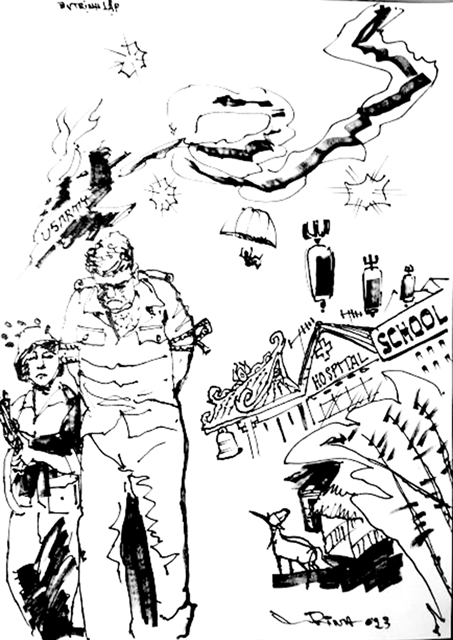 Talk Around Town
Talk Around Town

 |
| Illustration by Trịnh Lập |
by Nguyễn Mỹ Hà
The former US secretary of state Henry Kissinger died last week, ending a life that spanned the most brutal wars of the 20th century. He lived a long life and was active until his final years, and it's hard to judge him from an outsider's viewpoint. Here we're only discussing his part during the US involvement in Việt Nam and his role in the negotiations to end the US military presence in Việt Nam.
The Paris Peace Accords, officially titled the Agreement on Ending the War and Restoring Peace in Việt Nam, was signed on January 27, 1973.
After the war in Việt Nam, the US foreign policy under various presidents continued upholding their "world safeguarding mission", only to get involved in more wars, deaths and destruction worldwide: Afghanistan in the 1980s, the invasion of Iraq in 1991, Yugoslavia in the 1990s, then Syria in the 2000s after 9/11. The list goes on.
It seems no lessons have been learned from what happened in Việt Nam more than 50 years ago.
Negotiations started in 1968 in Paris with four parties representing the Democratic Republic of Việt Nam (DRV), the Provisional Revolutionary Government of the Republic of South Việt Nam (RSV), the United States, and the Republic of Việt Nam (RVN).
Talks were stuck with no development on the negotiation table. Leading the DRV delegation were Foreign Minister Xuân Thủy and Special Advisor Lê Đức Thọ. Madame Nguyễn Thị Bình represented the Revolutionary Government of the RSV on one side, on the other side were Foreign Minister of the RVN Trần Văn Lắm and the US negotiators Cyrus Vance, and National Security Advisor Henry Kissinger, whose name continued to make headlines around the world half a century later.
During the talks, when negotiation got stuck in 1968 and later in 1969, the leadership in Hà Nội then, particularly President Hồ Chí Minh, whose health was deteriorating, and the Politburo anticipated a fierce aerial battle between the US air force and the young flying force of North Việt Nam.
A long list of actions were to take place: schools and children had to evacuate from the cities of Hà Nội, Hải Phòng and Nam Định, and factories and public offices also evacuated to the countryside, where they were hosted by even poorer farmers ready to share their simple homes.
Everyone was expecting the escalation of war, and a heavy atmosphere hung in the air from cities to country; the winter of 1972 was getting closer, but everyone was hoping for peace.
On the night of December 18, 1972, the US launched an air campaign of destruction against North Việt Nam, deploying 741 B-52 flying fortresses to drop 15,237 tons of ordnance on 18 industrial and 14 military targets, including eight SAM sites.
The operation first destroyed a section of Hà Nội's Long Biên Bridge, dropped bombs on Bạch Mai Hospital, and pulled down the 5-storey Library building of Hà Nội's Foreign Languages College.
Most notoriously on the night of December 26, B-52 bombs levelled part of Khâm Thiên Street, killing 287 people, and wounding 290 others. More than 500 houses were destroyed, and 1,200 others were damaged.
During this uneven aerial battle, the North Vietnamese army reported that 34 B-52s were shot down during the 12 days and nights of the campaign.
The target of this operation by the US air force was to use the most destructive weapons, not only to push Việt Nam "back to the Stone Age", but to make the Vietnamese negotiators in Paris give in to the US terms of the accords.
During the 1972 Christmas bombings, the Politburo determined that the number of B-52s shot would be significant enough to bring the US negotiators back to the table. It was.
After the Paris Peace Accords were signed to end US involvement in Việt Nam, the top two negotiators Lê Đức Thọ and Henry Kissinger were awarded the Nobel Peace Prize.
Thọ is still the only Nobel winner to turn down the peace prize, saying he would not stand on the same level as someone who invaded his country, and bombed his home. Real peace had not yet been restored in Việt Nam, and he could not accept it.
By turning it down, Thọ saved his and the country's dignity. The US$4 billion aid, part of the peace accords, that should have helped to remove the scars of wars in Việt Nam was never committed.
Since the normalisation of relations between Việt Nam and the US in 1995, the two countries' trade has grown yearly. From 2012 until 2022, Việt Nam-US trade value grew from $25 billion to $123 billion.
Children born in Việt Nam today may not know much about the distant wars, and what their forefathers and mothers went through. Their inheritance is Việt Nam's right to be one unified country, and not be led by world superpowers on any front, be it on the battlefield or negotiating table.
Today, a monument to commemorate those who died in Hà Nội stands in a corner of Khâm Thiên Street. Five US presidents visited Việt Nam in the years since relation normalisation in 1995. None apologised, and none visited any war memorials.
The most recent visit by President Biden saw him pay floral tribute at a memorial where US pilot John McCain was shot down on Hà Nội's Trúc Bạch Lake. We have seen no remorse ever shown by any US government representatives. VNS




